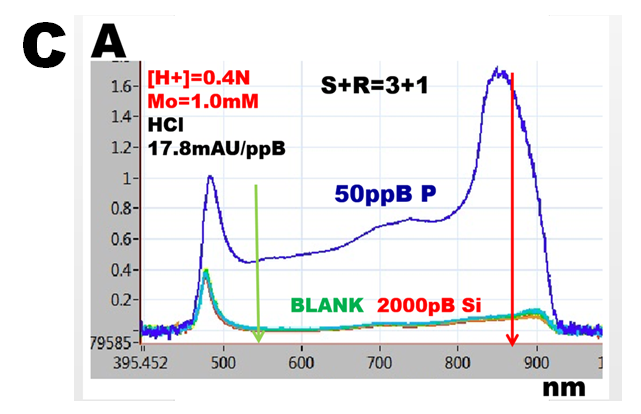How to Optimize PMoB Assay
The importance of using correct combination of acid and molybdate concentrations was recognized long time ago, by Going and Eisenreich (1974) and confirmed by Pai et al. (1990), who recommended use [H+]/[Mo] ratios as a tool for optimization of PMoB method. However, this concept was recently rejected (Nagul et.al. 2015 Section 6) “because it fails to define any chemical property of MB system and is extremely misleading”.
In [H+] diagrams the averaged value of all optimized [H+]/[Mo] for hydrochloric (1.5.11.) and nitric acid (1.5.12.) is 300, while for sulfuric acid (1.5.10.) it is higher ([H+]/[Mo] = 400 ), because sulfuric acid is not fully dissociated in this range of acidities. In summary, while use of [H+]/[Mo] ratio for optimization of reagent composition is convenient, it might be misleading. Therefore, use of [H+] diagrams is preferable for the method optimization. It should also be noted that because hydrochloric acid can be purified from traces of phosphate by isothermal distillation, it is more suitable for this assay than sulfuric acid.
1) To maximize sensitivity adjust step 3 of the assay protocol, (1.2.36.A.) to mix the sample with the reagents in proportion 3+1.
2) From [H+] diagram select [Mo]&[H+] combination within the optimized range. Higher acidity is preferable because it will eliminate interference from silica. As an example, when the flow cell contains the reaction mixture composed of [Mo]=1.0mM, [H+] = 0.4N HCl, 0.015mM KSb tartrate as well as 0.75% (43mM) ascorbic acid and 0.325% sodium dodecyl sulphate, (obtained from 8x more concentrated input reagents), the calibration experiment A will yield a calibration line B with a slope of 17.7mAU/ppB P and a LOD = 30nM P.
3) Record spectra of 50ppB P standard and BLANK and compare with features shown here (C).
Increase acidity if BLANK spectrum shows a peak, decrease acidity if peak of P standard at 880nm, is low.
4) Prepare standards of silica and repeat calibration experiment with BLANK and 1000 and 2000 ppM Si.
It may be maintained that using maximum slope is not necessary, and selecting the monitored wavelength at 880nm is not crucial, as long as the calibration line can be reliably reproduced. And it is true that a “suitable” (e.g. 650nm) wavelength can be located when calibration performed at 880nm fails (D).
However, when calibration at marginal conditions is reproducible, the sensitivity of assay will be compromised. Moreover differences in composition of matrix between standards and samples may cause undetected errors. Therefore it is essential to operate within the optimized [H+]&[Mo] range, and at higher acidities, where influence of silica and difference in matrix composition between samples and standards are avoided.



